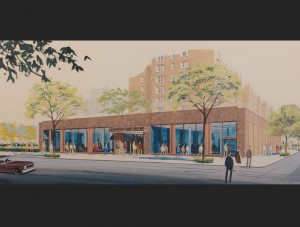
Armchair, mahogany & brass (1810-15). Attributed to Duncan Phyfe & Son (1770-1854). Source: The Metropolitan Museum of Art Collections.
In 1784, Duncan Phyfe arrived in New York a struggling immigrant apprenticed to a cabinetmaker. By the early 1800s, he had built for himself such a demand that he was known as the “United States Rage.” Between 1805 and 1847, Phyfe was the dominant furniture maker of the elite moneyed class of New York, Philadelphia, and the American South, but within a generation of his retirement, his name was nearly forgotten (The Metropolitan Museum of Art). The Metropolitan Museum of Art’s exhibit Duncan Phyfe Master Cabinetmaker in New York, on view through May 6, is the first retrospective on this titan of cabinetry in ninety years. Organized chronologically, the exhibition is a sweeping view of Phyfe’s life and work including never-before-seen masterpieces, drawings, documents, and even the cabinetmaker’s own tool chest.

The Shop and Warehouse of Duncan Phyfe, 168–172 Fulton Street, New York City Formerly attributed to John Rubens Smith (American, London 1775–1849 New York City). Source: The Metropolitan Museum of Art Collections.
Phyfe’s primary design structure was neoclassical, influenced by Greek and Roman forms and ornaments such as the carved lion’s foot on the chair above, incorporating a wide range of 19th century classical styles such as Empire, Sheraton and Regency. His name is connected with an astonishingly long list of furniture styles, including reeded leg sofas and central pedestal drop leaf breakfast tables, as well as elegant form motifs such as his famous lyre design. Eloquent and unaffected, the style of Duncan Phyfe was so widely imitated while his own work was so rarely signed that it is now difficult to determine which pieces are “originals.” And while Phyfe faded into obscurity, his design aesthetic became an indelible part of the landscape of American furniture. For the first time, by matching rare bills of sales and other documents, this exhibition is able to document his particular work over time, and reintroduce this forgotten master to the world.


